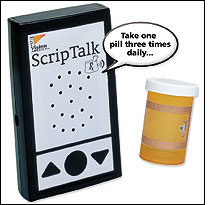How do visually impaired people tell one type of medication in their cabinet from another? Some put rubber bands around bottles; others put bottles in different areas of the cabinet. But rubber bands break, and bottles get knocked to the floor, causing patients to sometimes take the wrong medication.
En-Vision America has come up with a solution—ScripTalk, an RFID system that lets people listen to the instructions on a bottle of medicine.

The company says Kohll’s Pharmacy & Homecare in Omaha, Neb., is running a pilot, and so far the results have been good. People like having the medication label read to them, and Kohll’s likes being able to better serve its customers, which should lead to greater customer loyalty.
The system is simple and elegant. En-Vision provides pharmaceutical labels with an embedded 13.56 MHz microchip from French RFID company Inside Contactless. En-Vision sells pharmacies a printer-encoder from Zebra Technologies that prints all of the necessary prescription information on the label and encodes the same information on the embedded chip, which can hold 2 kilobytes of data.
The pharmacy sells patients a cigarette pack-sized device that interrogates, or reads, the tag. The device, which costs about $300, passes all of the information to a speech synthesis microchip that converts the digital information on the tag into words. When patients pick up a bottle and hold it near the ScripTalk device, they hear their name, the name of the drug, the dosage, general instructions and so on.
En-Vision America, which began developing the product in 2000, has been working to lower the costs of the components. Late last year, the company received a blanket purchase agreement from the United States Veterans Administration, so any of the 175 VA hospitals can purchase the printers, labels and readers for visually impaired veterans.
Dave Raistrick, vice president of En-Vision, says the printers have been installed in roughly 30 VA facilities and about 2,000 people are currently using the ScripTalk device. He estimates that as many as 6,000 veterans might be using it by the end of the year. “ScripTalk has been real successful on the governmental side,” he says. “Now, we’re looking to roll it out to retail pharmacies. Kohll’s is first, but we’re talking to some of the big chains as well.”
En-Vision is now upgrading the system to hold additional information, such as common side effects and what to do if you miss a dose. The voice synthesis is also being enhanced to sound less robotic. Raistrick expects the new, more consumer-friendly version will be available from pharmacies next year. “This is just the beginning of what can be done with RFID-enabled labels,” he says. “Instead of just telling people what the medication is, we might be able to help people remember to take it.”

